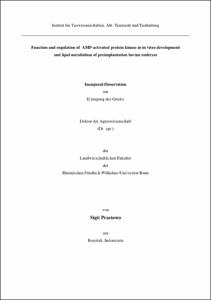Function and regulation of AMP-activated protein kinase in in vitro development and lipid metabolism of preimplantation bovine embryos

Function and regulation of AMP-activated protein kinase in in vitro development and lipid metabolism of preimplantation bovine embryos

| dc.contributor.advisor | Schellander, Karl | |
| dc.contributor.author | Prastowo, Sigit | |
| dc.date.accessioned | 2020-04-20T07:49:13Z | |
| dc.date.available | 2020-04-20T07:49:13Z | |
| dc.date.issued | 14.07.2015 | |
| dc.identifier.uri | https://hdl.handle.net/20.500.11811/6252 | |
| dc.description.abstract | One of the major problems associated with the in vitro production of bovine embryos is lipid accumulation due to the presence of serum in culture media. AMP-activated protein kinase (AMPK) is well documented as a master regulator of energy metabolism, particularly lipid metabolism, in mammalian cells. The present study aimed to explore the potential role of the AMPK pathway in bovine embryos related to lipid accumulation. For this, the whole study was divided into 3 experiments. In experiment 1, the AMPK activity of in vitro produced blastocysts in the presence or absence of serum was analyzed and associated with lipid metabolism phenotypes. In experiment 2, 5-aminoimidazole-4-carboxamide riboside (AICAR) was applied to enhance AMPK activity during in vitro culture, to investigate its effect on embryo development rate, blastocyst cell number, AMPK activity, mitochondrial activity and the expression of lipid metabolism genes. Furthermore in experiment 3, the post transcriptional regulatory mechanism of AMPKA1 gene was investigated in bovine granulosa cells. The results showed that the presence of serum suppressed the expression of genes in the AMPK pathway (AMPKA1, STK11) and mitochondrial activity (CPT1, PGC1A), while the expression of lipid synthesis gene (ACC) was significantly increased. In addition to the reduced activity of AMPK, the presence of serum increased the level of ROS accumulation followed by low mitochondrial activity in resulting blastocysts. The application of AICAR during embryo culture showed no impact on embryo development rate but significantly reduced blastocyst cell number. The presence of AICAR increased the expression AMPKA1, STK11, CPT2, PGC1A, NQO1 genes, while ACC was suppressed. In experiment 3, in silico study predicted 11 miRNAs as potential regulators of AMPKA1. The miRNA profiling in granulosa cells showed that miR-33b is the most abundant miRNA accompanied by low expression of AMPKA1 and high lipid droplet accumulation. Luciferase assay validated the binding of miR-33b and the 3’UTR of AMPKA1. Inhibition of miR-33b resulted in up regulation of AMPKA1 and significantly increases PGC1A gene expression. Moreover, miR-33b was highly expressed in blastocysts derived from culture with serum, while AMPKA1 showed a reverse pattern compared to without serum. Altogether, the present study demonstrates that expression of AMPK and lipid metabolism pathway in blastocysts were affected by the presence of serum in culture media leading to accumulation of lipid. | en |
| dc.description.abstract | Funktion und Regulation der AMP aktivierte Proteinkinase in der in vitro Produktion und dem Lipidmetabolismus von präimplantierten Embryonen Ein Hauptproblem bei der in vitro Produktion von bovinen Embryonen ist die Lipidanreicherung, die durch das im Kulturmedium enthaltene Serum entsteht. AMP aktivierte Proteinkinase (AMPK) ist ein Hauptregulator für den Energiemetabolismus vor allem des Lipidmetabolismus in Säugetierzellen. Das Ziel der vorliegenden Studie war die Rolle des AMPK Signalwegs in bovinen Embryonen in Verbindung zur Lipid Anreicherung zu untersuchen. Dafür unterteilte sich die vorliegende Studie in 3 experimentelle Ansätze. Im ersten Experiment wurde die AMPK Aktivität in in vitro produzierten Blastozysten in der An- und Abwesenheit von Serum analysiert und in Verbindung zum Lipidmetabolismus gesetzt. Im zweiten Experiment kam AICAR für die Verbesserung der AMPK Aktivität während der in vitro Kultur zum Einsatz. Dabei sollte der Effekt von AICAR auf die embryonale Entwicklungsrate, Blastozystenzellzahl, AMPK Aktivität, Mitochondrienaktivität und die Expression von Genen des Lipidmetabolismus untersucht werden. Zusätzlich wurden im dritten Experiment post transkriptionelle regulatorische Mechanismen des AMPKA1 Genes in bovinen Granulosazellen untersucht. Die Ergebnisse zeigten, dass das Serum die Expression der Gene des AMPK Signalwegs (AMPKA1, STK11) und der Mitochondrienaktivität (CPT1, PGC1A) unterdrückt, wohingegen die Genexpression der Lipidsynthese (ACC) signifikant erhöht war. Zusätzlich zu der reduzierten AMPK Aktivität erhöht das Serum das ROS Level gefolgt von einer geringen Mitochondrienaktivität in den Blastozysten. Die AICAR Zugabe während der Embryokultur zeigte keinen Einfluss auf die embryonale Entwicklungsrate, aber eine signifikant reduzierte Blastozystenzellzahl. AICAR erhöhte die Genexpression von AMPKA1, STK11, CPT2, PGC1A sowie NQO1 und unterdrückte die Genexpression von ACC. Die in Experiment drei durchgeführte in silico Untersuchung erbrachte 11 miRNAs als potentielle AMPKA1 Regulatoren. Die miRNA Profilanalyse in Granulosazellen zeigte, dass die miR-33b am höchsten detektiert war woraus eine geringe AMPKA1 Expression sowie eine hohe Lipidtröpfchenanreicherung resultierte. Durch den Luciferase Assay konnte die Bindung zwischen der miR-33b und der 3’UTR des AMPKA1 überprüft werden. Eine miR-33b Hemmung resultierte in einer Hochregulierung des AMPKA1 und einen signifikanten Anstieg der PGC1A Genexpression. Außerdem war die miR-33b von in Serum kultivierten Blastozysten hoch exprimiert, wohingegen AMPKA1 ein gegenläufiges Muster im Vergleich zu serumfreien Blastozysten zeigte. Zusammenfassend veranschaulicht die vorliegende Studie, dass die AMPK Expression und der Signalweg des Lipidmetabolismus in Blastozysten durch das Serum im Kulturmedium beeinflusst werden sowie zur Lipidanreicherung führt. | en |
| dc.language.iso | eng | |
| dc.rights | In Copyright | |
| dc.rights.uri | http://rightsstatements.org/vocab/InC/1.0/ | |
| dc.subject.ddc | 630 Landwirtschaft, Veterinärmedizin | |
| dc.title | Function and regulation of AMP-activated protein kinase in in vitro development and lipid metabolism of preimplantation bovine embryos | |
| dc.type | Dissertation oder Habilitation | |
| dc.publisher.name | Universitäts- und Landesbibliothek Bonn | |
| dc.publisher.location | Bonn | |
| dc.rights.accessRights | openAccess | |
| dc.identifier.urn | https://nbn-resolving.org/urn:nbn:de:hbz:5n-40640 | |
| ulbbn.pubtype | Erstveröffentlichung | |
| ulbbnediss.affiliation.name | Rheinische Friedrich-Wilhelms-Universität Bonn | |
| ulbbnediss.affiliation.location | Bonn | |
| ulbbnediss.thesis.level | Dissertation | |
| ulbbnediss.dissID | 4064 | |
| ulbbnediss.date.accepted | 06.07.2015 | |
| ulbbnediss.institute | Landwirtschaftliche Fakultät : Institut für Tierwissenschaften (ITW) | |
| ulbbnediss.fakultaet | Landwirtschaftliche Fakultät | |
| dc.contributor.coReferee | Sauerwein, Helga |
Files in this item
This item appears in the following Collection(s)
-
E-Dissertationen (1108)




